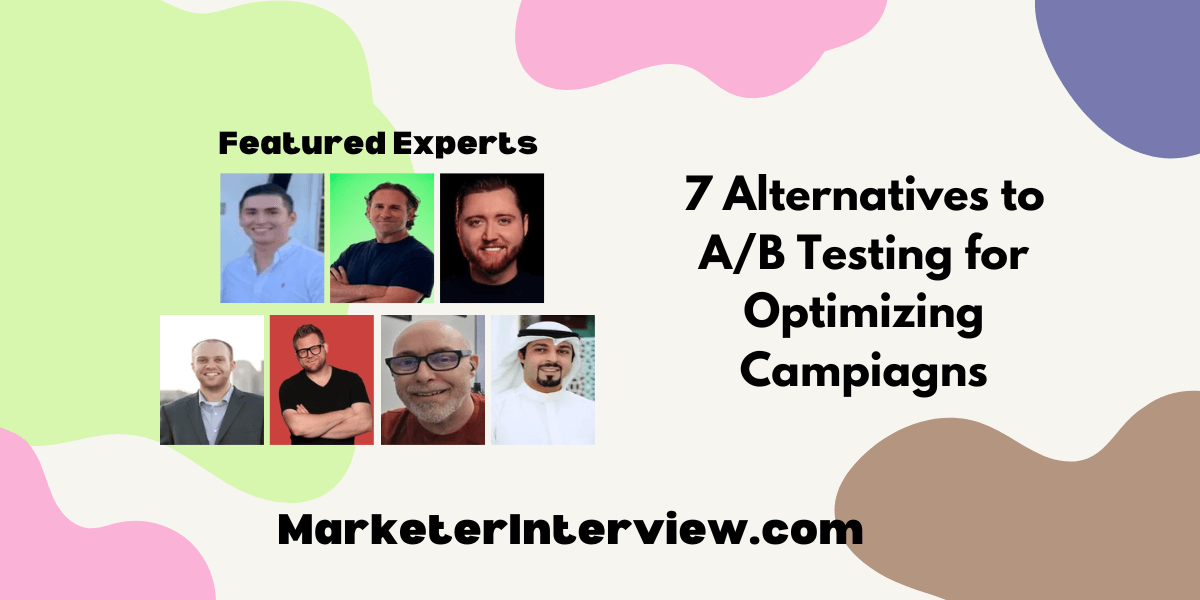7 Alternatives to A/B Testing for Optimizing Campiagns
Exploring alternatives to A/B testing can offer fresh perspectives on optimizing campaigns, so we turned to seven marketing experts and company leaders for their unique strategies. From leveraging multi-variant testing to gathering insights through customer surveys, these professionals, including Founders and a President, share their personal experiences and innovative approaches.
Want to get quoted in MarketerInterview.com content just like this? Apply to become a contributor today!
Contents
Leverage Multi-Variant Testing
Multi-variant testing has been an alternative I’ve leveraged with success. Rather than relying on a single A/B test winner, multi-variant testing allows the testing of multiple variations simultaneously, shifting traffic dynamically based on performance.
For a client’s email campaign, we tested 8-10 subject lines, content variations, and send times. An algorithm evaluated open and click rates in real-time, shifting more traffic to top performers. Open rates rose 32% and CTR increased by 60% over the month-long campaign. Starting small, observing variations, and then allocating more traffic to winners optimizes experiences and maximizes revenue. Tools like Optimizely and VWO offer multi-variant testing, but custom solutions allow for dynamic changes based on data.
Multi-variant testing requires sophistication, but when done right, it takes optimization and personalization to the next level. For marketers seeking more from their campaigns, I highly recommend exploring multi-variant testing.

Chase Chappell, Founder, Sirge
Optimize with Multi-Page Testing
Multi-page testing is an optimization technique I’ve used to improve email campaigns. Instead of picking a single winner from an A/B test, multi-page testing tests multiple variations at once and shifts traffic based on performance.
For a healthcare client, we tested 10 subject lines, content variations, and send times. We analyzed open and click rates to see what performed best, then shifted more traffic to the top performers.
Open rates rose 32% and click-through rates jumped over 60%. The key is starting small, seeing how variations do, then using data to send more traffic to winners. This optimizes the experience, maximizes results, and increases revenue. Tools like Optimizely and VWO help, but custom solutions provide more control to make quick data-based changes.
Multi-page testing requires sophistication but pushes optimization and personalization further. For marketers who want to improve their email campaigns, I highly recommend exploring multi-page testing.

Josh Cremer, CEO, and Creative Director, Redfox Visual
Employ Multi-Armed Bandit Algorithms
One specific alternative to A/B testing for optimizing campaigns is using multi-armed bandit algorithms. Unlike A/B testing, which splits traffic evenly, this approach dynamically allocates more traffic to better-performing variations in real time. While running a PPC campaign, employing this method significantly increased conversions and reduced costs by continuously favoring the top-performing ads. This adaptive strategy allows for faster optimization and more efficient use of resources, ensuring the best outcomes without the prolonged testing phases typical of traditional A/B testing.

Ryan Doser, Co-Founder, AI Insider Tips
Utilize Heatmaps and Session Recordings
Website heatmaps and session recordings offer a faster, qualitative approach to understanding user behavior compared to A/B testing. Heatmaps visually show where users click, scroll, and drop off on a page, helping identify areas of confusion or low engagement. Repositioning hidden CTA buttons can increase clicks by 20%. Session recordings show real user interactions, improving completion rates by 15%. While A/B testing is powerful, heatmaps and recordings offer a faster, qualitative way to optimize content for better results.

Dhari Alabdulhadi, CTO and Founder, Ubuy Kuwait
Conduct Heuristic Evaluation for Quick Insights
A technique we’ve utilized as an alternative to A/B testing is heuristic evaluation. This involves a more qualitative approach where experts in UX and conversion rate optimization review a site or campaign based on established usability principles. By employing this method, we bypass the need for live testing and instead use the expertise of seasoned professionals to identify potential friction points and areas for improvement. In one memorable project, our analysis led to a redesign of a client’s checkout process, which had been identified as overly complex and confusing. The changes implemented based on our heuristic evaluation resulted in a significant uplift in completed purchases, proving that expert insight can sometimes lead to quicker and highly effective optimizations without the need for extended testing periods.

Marc Bishop, Director, Wytlabs
Target with Geofencing Techniques
Geofencing works by setting up virtual boundaries around a particular area, such as a neighborhood or community. Once these boundaries are established, anyone who enters the designated area will trigger a notification or ad on their mobile device. These notifications can be customized with personalized messages and calls to action, making them more effective than traditional advertisements.
One of the main advantages of using geofencing as an alternative to A/B testing is that it allows for highly targeted marketing. With A/B testing, you are essentially splitting your audience in half and showing them different versions of your campaign. However, with geofencing, you can specifically target individuals who are already in the market for a particular type of property or have shown interest in similar listings in the past.
Personally, I have had great success with using geofencing to promote open houses and new listings. By setting up virtual boundaries around a specific neighborhood or community where I have a listing, I am able to attract potential buyers who are actively looking in that area. This has resulted in higher attendance at open houses and more inquiries about the property.
Additionally, geofencing also allows for more precise tracking and measuring of campaign effectiveness. With A/B testing, it can be difficult to determine which version of the campaign is truly generating results. But with geofencing, I am able to track exactly how many people received my notification and clicked on it, providing a clearer understanding of ROI.

John Jones, Real Estate Investor, Sell My House Fast Now
Gather Insights Through Customer Surveys
I have found that one specific alternative to A/B testing for optimizing campaigns is implementing customer surveys. By directly asking our target audience for feedback, we gain valuable insights into their preferences and pain points. For example, we recently conducted a survey before launching a new product, and the feedback helped us shape our marketing strategy. This approach not only saved us time and resources but also led to a more targeted and successful campaign.
Another effective alternative is conducting focus groups. By bringing together a small group of our target customers, we can observe their reactions in real time and gather qualitative feedback. Recently, we hosted a focus group to test a new advertising concept, and the discussions sparked new ideas that we hadn’t considered. The insights we gained allowed us to refine our messaging and design, resulting in a more engaging campaign.
In conclusion, while A/B testing is a valuable tool, customer surveys and focus groups offer unique opportunities to connect with our audience on a deeper level. By incorporating these alternatives into our campaign optimization strategies, we can make more informed decisions and create more impactful marketing initiatives. It’s essential to remember that listening to our customers is key to success in the ever-evolving landscape of digital marketing.

Josh Ladick, President, GSA Focus
Want to get quoted in MarketerInterview.com content just like this? Apply to become a contributor today!






